Abstract
Data on the biology of Dasyatis pastinaca are absent from the Ionian Sea and only a few studies were conducted in the Mediterranean Sea. Some biological and ecological aspects of D. pastinaca were investigated between November 2019 and February 2020 in the central Mediterranean Sea. In particular, we investigated several morphologic, population and ecological aspects of the species. The analysis of the stomach contents showed that D. pastinaca is a generalist carnivorous, mainly feeding on small crustaceans and polychaetes. The Levin’s index value (Bi) was 0.85. The sex ratio showed no significant differences from 1:1 ratio. Females were larger than males, but no statistical differences were found in disc width-weight and total length-disc width relationships between sexes. Most of the specimens caught were juveniles and inhabit shallow sandy bottoms.
1. Introduction
Elasmobranchs are key top predators in most marine environments and play an essential role in regulating and structuring marine ecosystems [1,2]. On the other hand, due to their low fecundity and delayed age at maturity, elasmobranchs are highly vulnerable to fishing activity and are often affected by high by-catch rates [3,4]. All this is reflected in the dramatic decline of shark and ray populations and, as demonstrated by several researches conducted in the Mediterranean Sea over the last decades, most species of elasmobranchs have dramatically declined in number mainly due to overfishing and illegal fishing [5,6,7,8,9].
In Italian seas, stingrays (Dasyatidae) are represented by 4 species and 3 genera [10]: Dasyatis Rafinesque, 1810, Pteroplatytrygon Fowler, 1910 and Taeniura Müller & Henle, 1837. The genus Dasyatis comprises Dasyatis pastinaca (Linnaeus, 1758) and Dasyatis centroura (Mitchill, 1815). These two species are very similar but can be distinguished by the presence (D. pastinaca) or absence (D. centroura) of a dorsal keel behind the spine on the tail and by the presence of quite developed spines and tubercles on the dorsal surface of the body and tail in large specimens of D. centroura [11]. Furthermore, between all the Mediterranean species of the genus Dasyatis, D. pastinaca is the most abundant and widely distributed one [12]. Pteroplatytrygon violacea (Bonaparte, 1832) is a less common species than D. pastinaca, while Taeniura grabata (Geoffroy Saint-Hilaire, 1817) is very rare and was only occasionally caught in the Mediterranean, and only once in Italian waters [10,13]. Because of their low or no commercial value, stingrays are usually discarded [14,15,16]. However, due to their vulnerability to fishing activities, the conservation and correct management of these vulnerable K-selected species require special efforts to ensure their perpetuation.
The common stingray, D. pastinaca, is an Atlantic-Mediterranean species whose distribution extends from the southwestern Baltic Sea and throughout the Mediterranean Sea to Senegal [17]. It is listed as “data deficient” in the IUCN Red List [18]. The common stingray inhabits soft bottoms of coastal waters, down to a depth of about 200 m [19,20]. It is commonly caught with trammel nets and trawls and usually discarded [14,15,16]. The maximum recorded disc width (DW) is 64 cm, but common sizes range from 20 to 40 cm DW. The survival rate of this species, when caught with trammel net, is equal or close to 0 [16]. Indeed, because of their defensive behavior, fishermen are forced to kill the stingrays with the aim of avoiding serious injuries from their venomous spine on the tail. Another noteworthy fact of this species is the antimicrobial and anti-proliferative effects of its skin mucus [21].
Data on the biology and ecology of D. pastinaca in the Mediterranean Sea are scarce, and no data are available from the Ionian Sea. Therefore, the aim of this study is to provide new data on the biology and ecology of the common stingray, providing the first data from specimens from the Ionian Sea. In particular, we investigated size frequency distribution, sex ratio, disc width-weight relationships, total length-disc width relationships, diet composition and habitat of D. pastinaca from specimens caught as discards in trammel nets targeting cuttlefish, Sepia officinalis Linnaeus, 1758, in the central Mediterranean Sea.
2. Materials and Methods
A total of 120 specimens of D. pastinaca were collected along the coastline extending for about 21 km in the southeast coast of Sicily (Ionian Sea), from Avola to Marzamemi (Figure 1). The specimens were caught by professional fishermen at 5–30 m depth between the 10 November 2019 and 10 February 2020 with trammel nets targeting cuttlefish (S. officinalis) [16]. Trammel nets were deployed overnight (from 6 pm to 4 am) for about 10 h, on sandy and mixed bottoms (sand and rocks), close to Posidonia oceanica seagrass meadows. In order to better represent the population, specimens were randomly selected from different fishing vessels operating in the area. Data about bottom nature and depth of capture were collected through interviews to fishermen.
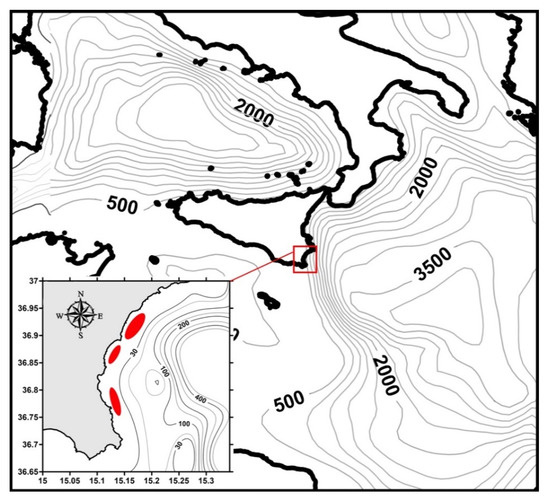
Figure 1.
Study area (indicated in red) in the Ionian coast of Sicily (central Mediterranean Sea).
Each specimen was weighed and measured (disc width and total length). The sex was determined by the presence (male) or absence (female) of claspers. Weight and disc width measures were used for the disc width-weight relationships following the formula: W = aDWb, where W is the weight in grams (g), DW is the disc width in centimeters (cm), a is the intercept and b is the slope of the regression curve. Total length (TL) and disc width measures were used for the total length-disc width relationships following the formula: DW = yTL + x, where y is the slope and x is the intercept of the regression line. Disc-width frequency distributions were constructed for both sexes. A chi-square test was used to verify if there was a significant difference (α = 0.05) between the observed and the expected sex ratio (M:F, 1:1) of the whole sample. To test if the regressions of the weight (W) on disc width (DW) were significantly different (α = 0.05) for the two sexes, and to test if the regressions of the disc width on total length (TL) were significantly different (α = 0.05) for the two sexes, an analysis of covariance (ANCOVA) was employed. Five outliers (females > 2143 g) were excluded from the analyses.
The stomach was removed from each fish as soon as possible after landing, and its content analyzed. All the prey items in the stomachs were counted, washed in clean seawater and dried with blotter paper, identified under a microscope to the lowest taxonomic level possible and weighed to the nearest 0.01 g.
The frequency of occurrence (%F), percentage weight (%W), percentage abundance (%N) and the Index of Relative Importance (%IRI) were calculated for each prey category [22,23]. The vacuity index (percentage of empty stomachs) was also calculated.
According to the value of their percentage abundance (%N), prey were grouped into three categories [24]: dominant (N > 50%), secondary (10% < N < 50%) and accidental (N < 10%).
The feeding strategy of D. pastinaca was visually examined using a modified version of the Costello (1990) graph [25] by plotting the prey-specific biomass (Pi) against their frequency of occurrence (%F) [26]:
where Pi is the prey-specific biomass of prey i, SWi the stomach content biomass of prey i, and SWti the total stomach content biomass in those predators with prey i in the stomach.
Standardized Levin’s index (Bi) was used to evaluate the breadth of the diet [27]:
where pj is the relative frequency specimens in the jth prey item and Bmax is the total number of prey item categories found. Bi is comprised between 0 and 1. The more the value of Bi is close to 0, the narrower is the trophic niche of the species investigated. Conversely, the closer the value of Bi is to 1, the wider the trophic niche. Hence, if Bi < 0.40, the species is considered a “specialist feeder”; if 0.40 < Bi < 0.60, the species is considered an “intermediate feeder”; if Bi > 0.60 the species is considered a “generalist feeder” [28].
A cumulative prey curve [29] was computed with R Studio [30] in order to evaluate whether the number of analyzed stomachs was sufficient to describe the diet of the species. The estimated number of prey groups with the associated SD were plotted against the cumulative number of individuals whose stomach was examined.
3. Results
Out of the total 120 specimens sampled, 57 (47.5%) were males and 63 (52.5%) were females. The sex ratio did not deviate significantly from 1:1 (M:F, 0.9:1; p-value > 0.05). Females were on average larger than males, ranging from 31 to 76.4 cm in total length, from 16.8 to 45.5 cm in disc width and from 144 to 3781 g in weight (Figure 2, Table 1). However, the ANCOVA test did not indicate significant differences (p-value > 0.05) in disc width-weight relationships between sexes and neither did total length-disc width relationships (p-value > 0.05). The disc width-weight relationships for both sexes and combined showed a positive allometry (Table 2, Figure 3). The parameters of the linear regression of the total length-disc width relationships were: DW = 0.641TL−4.2508 for males; DW = 0.641TL−4.122 for females; and DW = 0.641TL−4.1867 for combined sexes (Figure 4).
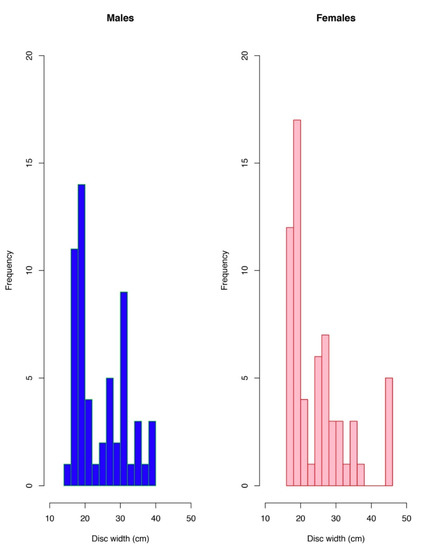
Figure 2.
Sex composition by size classes of Dasyatis pastinaca.

Table 1.
Sex distribution, total length, disc width and weight of Dasyatis pastinaca in the Ionian Sea (central Mediterranean Sea). The sex ratio (M:F, 0.9:1) was not significantly different from 1:1 (chi-square: p > 0.05).

Table 2.
Disc width-weight relationships parameters of D. pastinaca in the Ionian Sea (central Mediterranean Sea); C.I. = 95% confidence interval.
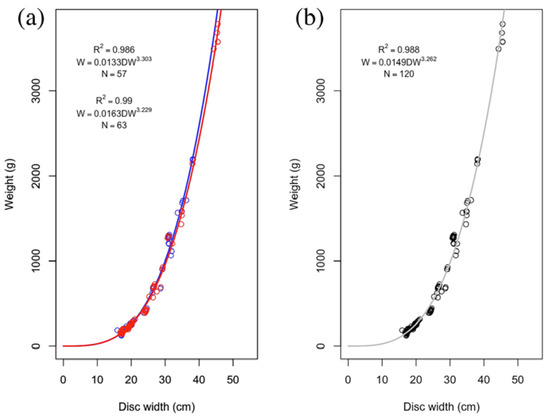
Figure 3.
Disc width-weight relationships of D. pastinaca for both sexes (a) and combined (b). A: in red for females (N = 63) and blue for males (N = 57).
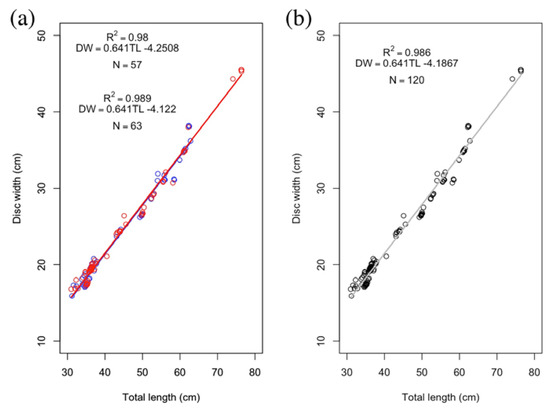
Figure 4.
Disc width-length relationships of D. pastinaca for both sexes (a) and combined (b). A: in red for females (N = 63) and blue for males (N = 57).
Considering the size at first maturity (L50 = 62.5 cm and 43 cm in DW for males and females, respectively) reported by a study conducted in the nearby Aegean Sea [31], a high percentage of specimens (virtually all males and the majority of females) were juveniles. All the specimens were caught on sandy bottom and within the whole bathymetric range investigated (5–30 m). A total of only 5 specimens (all females > 2143 g) were of relatively large size.
The cumulative prey curve showed that relatively few stomachs (about 50) are necessary for a reliable description of the diet of D. pastinaca (Figure 5). Out of the 120 specimens analyzed, only 67 had prey in their stomach (vacuity index of 55.83%). The stomach content analysis revealed that juveniles of D. pastinaca mainly feed on small benthic crustaceans and also, to a lesser extent, polychaetes (Table 3). Fish represented a negligible part of the diet. However, no preference for a particular prey was observed: the value of the standardized Levin’s index (Bi) was 0.85 (the digested category was included in the analysis), indicating a wide trophic niche. Most of the prey types were included into the category of “accidental prey” (N < 10%) (Table 3) and only a few (Amphipoda, Mysida and Lumbrineridae) were classified as “secondary prey” (10% < N < 50%). No dominant (N > 50%) prey types were found between the 13 identified items. Most of the prey were represented by small benthic invertebrates inhabiting sandy bottoms (Table 3). The values obtained for %IRI, %F and %W also indicated no clear dominance of any prey (Table 3). The same was clearly indicated by the plotted results of the main prey-specific biomass (Pi) against the frequency of occurrence (%F), being in agreement with results of the other previous analysis (Figure 6).
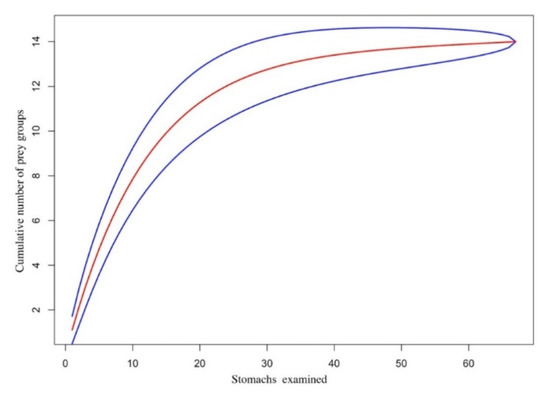
Figure 5.
Cumulative prey curve (in red) as a function of sample size for all stomachs analyzed of D. pastinaca. Standard deviation (SD) represented with blue lines.

Table 3.
Diet composition of D. pastinaca from the Ionian Sea (central Mediterranean Sea). %F = percentage frequency of occurrence; %N = percentage in number; %W = percentage in biomass; IRI = Index of Relative Importance of prey items and its percentage (%IRI). Values > 10% are in bold.
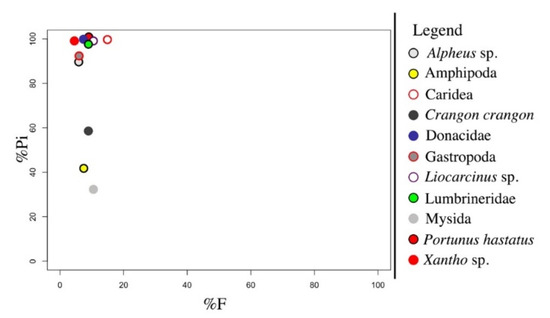
Figure 6.
Prey-specific biomass (Pi) plotted against the frequency of occurrence (%F) of the main prey items for D. pastinaca from the Ionian Sea (central Mediterranean Sea).
4. Discussion
With the exception of a few large female specimens, all or most of the individuals were juveniles. The sex ratio (statistically not significantly different from 1:1) of the fish caught during the study period indicates that there is no sexual segregation in juveniles of D. pastinaca.
The disc width-weight relationships showed a positive allometric growth in both sexes. Population structure and growth parameters, such as length-weight relationships are valuable measurements in order to evaluate the health conditions of fish populations [32] and are useful for comparisons of life histories of species among regions [33]. Also, total length-disc width relationships are valuable measurements to investigate intra and interspecific variation among populations [34]. Females showed larger sizes than males, but no significant differences were found in disc width-weight and total length-disc width relationships between the two sexes. Males and females attained smaller sizes than those of specimens from the Aegean Sea and Cilician Basin [31,35]. On the contrary, they reached similar size to those from the Iskenderun Bay [36]. Size differences appears to be related to the sampling depth. Indeed, while our specimens and those from the Iskenderun Bay were caught in shallow waters (5–30 and 0–50 m, respectively), the specimens from the other two Mediterranean areas (Aegean Sea and Cilician Basin) were collected in deeper waters (>50 m, down to a depth of 500 m). In consideration of this, we can speculate that juveniles of D. pastinaca use the study area, consisting of sandy bottoms of shallow waters close to Posidonia oceanica meadows, as a feeding ground. A similar result was obtained for juveniles of the rough ray, Raja radula Delaroche, 1809 [37].
On the basis of the number of specimens collected during the study period—and especially from interviews with local fishermen—D. pastinaca can be considered common in shallow waters of the Ionian coast of Sicily (central Mediterranean Sea). We also point out that in the investigated area D. pastinaca represented about 19% of the total elasmobranch catches in trammel nets targeting S. officinalis [16]. In the southeastern Sicily, the species is sympatric with other common species of elasmobranchs: R. radula and Torpedo torpedo (Linnaeus, 1758). However, while fishermen caught both adults and juveniles of T. torpedo [38], in R. radula, as in the case of D. pastinaca, most of the specimens were juveniles [37]. Furthermore, considering the different feeding habits between D. pastinaca and T. torpedo, their trophic niche does not overlap, resulting in little or no direct competition between these two species. Indeed, while D. pastinaca mainly feeds on small benthic crustaceans, as also demonstrated in this study, T. torpedo is a generalist piscivore [38,39]. The different diets of the two species (D. pastinaca and T. torpedo) can be explained by a different predation strategy. Indeed, only T. torpedo is capable of producing electric discharges to stun prey before swallowing them, and therefore this ambush predator feeds on more mobile and larger prey such as fish. Conversely, between D. pastinaca and R. radula the diet overlap was consistent. Both species mainly feed on small benthic crustaceans, with R. radula being a more selective feeder [37]. Hence, the differences in the diets of these species and, consequently, the different trophic competition between them, could be the cause, at least in part, of the different abundances of the species in the area: ~19%, ~33% and ~47% of the total catch of elasmobranchs, respectively for D. pastinaca, R. radula and T. torpedo [16].
Crustaceans (total percentage in number > 75%), followed by polychaetes, were the dominant prey. Considering the IRI, the main prey among crustaceans were represented by mysid shrimps, Liocarcinus sp. and Caridea. Other studies from other Mediterranean areas also showed similar results. In particular, Yeldan et al. (2009) [35] showed that the diet of specimens from Cilician coasts (Turkey) was mainly composed by crustaceans. Another study from the Black Sea (Turkey) [40] showed a similar result and similar results were also reported from the northeastern Atlantic (Azores) and from the eastern Adriatic Sea (Croatia) [41,42]. Furthermore, although the crustacean species composition varies between our and the above mentioned studies, some decapods species seem to be quite common in the diet of D. pastinaca and were reported from two or more of the above mentioned studies (including our study): Alpheus glaber (Olivi, 1792), Crangon crangon (Linnaeus, 1758), Liocarcinus depurator (Linnaeus, 1758) and Upogebia pusilla (Petagna, 1792). In all cases, the high value of the Levin’s index (0.85) and the plot of the prey-specific biomass (Pi) indicated that D. pastinaca is a generalist feeder.
In the marine environment, sharks and batoids often occupy the highest trophic levels of the food chain [43]. The key ecological role of these species is however threatened by human activities such as illegal fishing, overfishing and habitat destruction [1], which have in some cases led to dramatic shift in relative abundance, sometimes resulting in a great increase in smaller, lower-trophic level species. However, despite the importance of understanding the feeding relationships and the energy transfer in marine ecosystems, little is known about the feeding ecology of most elasmobranch species, and this is particularly true for batoids, which have received considerably less attention than sharks [44,45]. The importance of stingray predation in regulating the abundance and composition of prey in shallow waters has been demonstrated by several authors [46,47]. Hence, there is a need to protect these vulnerable and important key species. It therefore appears of great importance in management and conservation strategies such as, for example, the establishment of marine reserve, to have a good understanding of the trophic differences and relationships among species. Hence, we also need to deepen the knowledge about the trophic ecology of these species [48].
In conclusion, our study provides new data on the biology and ecology of D. pastinaca in the central Mediterranean Sea (where the only available data were from the eastern Adriatic Sea), and first data from the Ionian Sea. Dasyatis pastinaca juveniles were found common in sandy bottoms of the investigated area. Juveniles are quite active feeders, and mainly feed on small benthic invertebrates, with a general preference for decapod crustaceans and polychaetes. However, there was no clear preference of any particular species. Additional targeted studies are needed to provide new useful data for the management and protection of this potentially vulnerable k-selected species. Still little is known about several biological and ecological aspects of D. pastinaca, such as population structure, abundance, distribution and habitat selection and no data are available from the western part of the Mediterranean Sea. The experience and knowledge of fishery workers is a valid method for data collection [49,50]; a close collaboration between scientists and fishermen can lead to a better understating of the ecology and distribution of elasmobranchs.
Finally, particular attention is needed concerning the impacts of coastal fisheries on this and other coastal elasmobranch species. Considering the relatively high percentage of juveniles of the species of batoids caught in the area, a reduction of fishing pressure on these resources should be encouraged. A successful strategy could be the release of juvenile and adult specimens that are still alive and in good conditions in nearby selected areas immediately after landing.
Author Contributions
Conceptualization, F.T.; methodology, F.T. and G.M.; software, F.T.; validation, B.M.L.; formal analysis, F.T. and G.M.; investigation, F.T. and G.M.; data curation, F.T., G.M. and B.M.L.; writing—original draft preparation, F.T.; writing—review and editing, F.T., G.M and B.M.L.; supervision, B..M.L. All authors have read and agreed to the published version of the manuscript.
Funding
This research received no external funding.
Acknowledgements
We are grateful to the fishermen of Avola and Marzamemi for their support and willingness to freely share the information they had and for their help with the collection of the specimens.
Conflicts of Interest
The authors declare no conflict of interest.
References
- Stevens, J.D.; Bonfil, R.; Dulvy, N.K.; Walker, P.A. The effects of fishing on sharks, rays and chimaeras (chondrichthyans), and the implications for marine ecosystems. ICES J. Mar. Sci. 2000, 57, 476–494. [Google Scholar] [CrossRef]
- Bornatowski, H.; Navia, A.F.; Braga, R.R.; Abilhoa, V.; Corrêa, M.F.M. Ecological importance of sharks and rays in a structural foodweb analysis in southern Brazil. ICES J. Mar. Sci. 2014, 71, 1586–1592. [Google Scholar] [CrossRef]
- Ragonese, S.; Cigala Fulgosi, F.; Bianchini, M.L.; Norrito, G.; Sinacori, G. Annotated check list of the skates (Chondrichthyes, Rajidae) in the Strait of Sicily (central Mediterranean Sea). Biol. Mar. Mediterr. 2003, 10, 874–881. [Google Scholar]
- White, W.T.; Blaber, S.J.M.; Craig, J.F. The current status of elasmobranchs: Biology, fisheries and conservation. J. Fish Biol. 2012, 80, 897–900. [Google Scholar] [CrossRef] [PubMed]
- Soldo, A. Status of sharks in the Mediterranean. Ann. Ser. Hist. Nat. 2003, 13, 191–200. [Google Scholar]
- Cavanagh, R.D.; Gibson, C. Overview of the Conservation Status of Cartilaginous Fishes (Chondrichthyans) in the Mediterranean Sea; IUCN: Gland, Switzerland; Malaga, Spain, 2007; Volume VI, p. 42. [Google Scholar]
- Bradai, M.N.; Saidi, B.; Enajjar, S. Elasmobranchs of the Mediterranean and Black Sea: Status, Ecology and Biology Bibliographic Analysis; FAO: Rome, Italy, 2012; Volume X, p. 103. [Google Scholar]
- Giovos, I.; Stoilas, V.O.; Al-Mabruk, S.A.A.; Doumpas, N.; Marakis, P.; Maximiadi, M.; Moutopoulos, D.; Kleitou, P.; Keramidas, I.; Tiralongo, F.; et al. Integrating local ecological knowledge, citizen science and long-term historical data for endangered species conservation: Additional records of angel sharks (Chondrichthyes: Squatinidae) in the Mediterranean Sea. Aquat. Conserv. 2019, 29, 881–890. [Google Scholar] [CrossRef]
- Giovos, I.; Arculeo, M.; Doumpas, N.; Katsada, D.; Maximiadi, M.; Mitsou, E.; Paravas, V.; Aga-Spyridopoulou, R.N.; Stoilas, V.O.; Tiralongo, F.; et al. Assessing multiple sources of data to detect illegal fishing, trade and mislabeling of elasmobranchs in Greek markets. Mar. Policy 2020, 112. [Google Scholar] [CrossRef]
- Vacchi, M.; Serena, F. Chondrichthyes. Biol. Mar. Mediterr. 2010, 17, 642–648. [Google Scholar]
- Notabartolo di Sciara, G.; Bianchi, I. Guida Degli Squali e Delle Razze del Mediterraneo; Franco Muzzio: Padova, Italy, 1998; p. 388. [Google Scholar]
- Özbek, E.Ö.; Çardak, M.; Kebapçioglu, T. Spatio-temporal patterns of abundance, biomass and length-weight relationships of Dasyatis species (Pisces: Dasyatidae) in the Gulf of Antalya, Turkey (Levantine Sea). J. Black Sea Medit. Environ. 2015, 21, 169–190. [Google Scholar]
- Serena, F.; Silvestri, R.; Voliani, A. Su una cattura accidentale di Taeniura grabata (E. Geoffroy Saint-Hilaire, 1817) (Chondrichthyes, Dasyatidae). Biol. Mar. Mediterr. 1999, 6, 617–618. [Google Scholar]
- Relini, G.; Biagi, F.; Serena, A.; Belluscio, M.T.; Spedicato, P.; Rinelli, P.; Follesa, M.C.; Piccinetti, C.; Ungaro, N.; Sion, L.; et al. I Selaci pescati con lo strascico nei mari italiani. Biol. Mar. Mediterr. 2000, 7, 347–384. [Google Scholar]
- Scacco, U.; Andaloro, F.; Campagnuolo, S.; Castriota, L.; Vacchi, M. Cartilaginous fishes as a component of trawl discard in Strait of Sicily (Elasmobranch Fisheries—Oral). NAFO SCR Doc 2002, 2, 87. [Google Scholar]
- Tiralongo, F.; Messina, G.; Lombardo, B.M. Discards of elasmobranchs in a trammel net fishery targeting cuttlefish, Sepia officinalis Linnaeus, 1758, along the coast of Sicily (central Mediterranean Sea). Reg. Stud. Mar. Sci. 2018, 20, 60–63. [Google Scholar] [CrossRef]
- Froese, R.; Pauly, D. FishBase. Available online: http://www.fishbase.org (accessed on 15 January 2020).
- Serena, F.; Notabartolo di Sciara, G.; Ungaro, N. The IUCN Red List of Threatened Species. 2009. Available online: https://www.iucnredlist.org/species/161453/5427586 (accessed on 12 February 2020).
- Whitehead, P.J.P.; Bauchot, M.L.; Hureau, J.C.; Nielsen, J.; Tortonese, E. Fishes of the North-Eastern Atlantic and Mediterranean; Unesco: Paris, France, 1984; Volume 1-III, p. 1473. [Google Scholar]
- Fischer, W.; Bauchot, M.L.; Schneider, M. Fiches FAO D’indetification des Espèces Pour le Besoins de la Peche, Méditerranée et Mer Noire; FAO: Rome, Italy, 1987. [Google Scholar]
- Fuochi, V.; Li Volti, G.; Camiolo, G.; Tiralongo, F.; Giallongo, C.; Distefano, A.; Petronio, G.; Barbagallo, I.; Viola, M.; Furneri, P.M.; et al. Antimicrobial and anti-proliferative effects of skin mucus derived from Dasyatis pastinaca (Linnaeus, 1758). Mar. Drugs 2017, 15, 342. [Google Scholar] [CrossRef] [PubMed]
- Hyslop, E.J. Stomach content analysis, a review of methods and their application. J. Fish. Biol. 1980, 17, 411–429. [Google Scholar] [CrossRef]
- Carrassòn, M.; Matallanas, J.; Casadevall, M. Feeding strategies of deep-water morids on the western Mediterranean slope. Deep Sea Res. 1997, 44, 1685–1699. [Google Scholar] [CrossRef]
- N’Da, K. Regime alimentaire du rouget de roche Mullus surmuletus (Mullidae) dans le nord du golfe de Gascogne. Cybium 1992, 16, 159–168. [Google Scholar]
- Costello, M.J. Predator feeding strategy and prey importance: A new geographical analysis. J. Fish. Biol. 1990, 36, 261–263. [Google Scholar] [CrossRef]
- Amundsen, P.A.; Gabler, H.M.; Staldvik, F.J. A new approach to graphical analysis of feeding strategy from stomach contents data-modification of the Costello (1990) method. J. Fish. Biol. 1996, 48, 607–614. [Google Scholar] [CrossRef]
- Krebs, J.C. Ecological Methodology; Harper & Row: New York, NY, USA, 1989; p. 620. [Google Scholar]
- Novakowski, G.C.; Hahn, N.S.; Fugi, R. Diet seasonality and food overlap of the fish assemblage in a pantanal pond. Neotrop. Ichthyol. 2008, 6, 567–576. [Google Scholar] [CrossRef]
- Brown, S.C.; Bizzarro, J.J.; Cailliet, G.M.; Ebert, D.A. Breaking with tradition: Redefining measures for diet description with a case study of the Aleutian skate Bathyraja aleutica (Gilbert 1869). Environ. Biol. Fish. 2012, 95, 3–20. [Google Scholar] [CrossRef]
- R Development Core Team. R: A Language and Environment for Statistical Computing. Available online: http://www.R-project.org (accessed on 30 November 2018).
- Yigin, C.C.; Ismen, A. Age, growth and reproduction of the common stingray, Dasyatis pastinaca from the North Aegean Sea. Mar. Biol. Res. 2012, 8, 644–653. [Google Scholar] [CrossRef]
- Jones, R.E.; Petrell, R.J.; Pauly, D. Using modified length-weight relationships to assess the condition of fish. Aquacult. Eng. 1999, 20, 261–276. [Google Scholar] [CrossRef]
- Moutopoulos, D.K.; Stergiou, K.I. Length-weight and length-length relationships of fish species from Aegean Sea (Greece). J. Appl. Ichthyol. 2002, 18, 200–203. [Google Scholar] [CrossRef]
- Vargas-Caro, C.; Bustamante, C.; Lamilla, J.; Bennett, M.B. A review of the longnose skates Zearaja chilensis and Dipturus trachyderma (Rajiformes: Rajidae). Univ. Sci. 2015, 20, 321–359. [Google Scholar] [CrossRef]
- Yeldan, H.; Avsar, D.; Manasirh, M. Age, growth and feeding of the common stingray (Dasyatis pastinaca, L. 1758) in the Cilician coastal basin, northeastern Mediterranean Sea. J. Appl. Ichthyol. 2009, 25, 98–102. [Google Scholar] [CrossRef]
- Yeldan, H.; Gundogdu, S. Morphometric relationships and growth of common stingray, Dasyatis pastinaca (Linnaeus, 1758) and marbled stingray, Dasyatis marmorata (Staindachner, 1892) in the northeastern Levantine Basin. J. Black Sea Medit. Environ. 2018, 24, 10–27. [Google Scholar]
- Tiralongo, F.; Messina, G.; Cazzolla Gatti, R.; Tibullo, D.; Lombardo, B.M. Some biological aspects of juveniles of the rough ray, Raja radula Delaroche, 1809 in Eastern Sicily (central Mediterranean Sea). J. Sea Res. 2018, 142, 174–179. [Google Scholar] [CrossRef]
- Tiralongo, F.; Messina, G.; Brundo, M.V.; Lombardo, B.M. Biological aspects of the common torpedo, Torpedo torpedo (Linnaeus, 1758) (Elasmobranchii: Torpedinidae), in the central Mediterranean Sea (Sicily, Ionian Sea). Eur. Zool. J. 2019, 86, 488–496. [Google Scholar] [CrossRef]
- Romanelli, M.; Consalvo, I.; Vacchi, M.; Finoia, M.G. Diet of Torpedo torpedo and Torpedo marmorata in a coastal area of Central Western Italy (Mediterranean Sea). Mar. Life 2006, 16, 21–30. [Google Scholar]
- Saglam, H.; Ak, O.; Kutlu, S.; Aydin, I. Diet and feeding strategy of the common stingray Dasyatis pastinaca (Linnaeus, 1758) on the Turkish coast of southeastern Black Sea. Cah. Biol. Mar. 2010, 51, 37–44. [Google Scholar] [CrossRef]
- Santic, M.; Paladin, A.; Agovic, A. Diet of the common stingray, Dasyatis pastinaca (Chondrichthyes: Dasyatidae) in the eastern Adriatic Sea. Cah. Biol. Mar. 2011, 52, 349–356. [Google Scholar] [CrossRef]
- Ponte, D.; Barcelos, L.D.M.; Santos, C.; Medeiros, J.; Barreiros, P. Diet of Dasyatis pastinaca and Myliobatis aquila (Myliobatiformes) from the Azores, NE Atlantic. Cybium 2016, 40, 209–214. [Google Scholar]
- Compagno, L.J.V. Alternate life-history styles of cartilaginous fishes in time and space. Environ. Biol. Fish. 1990, 28, 33–75. [Google Scholar] [CrossRef]
- Motta, P.J. Prey capture behavior and feeding mechanisms of elasmobranchs. In Biology of Sharks and Their Relatives; Carrier, J.C., Musick, J.A., Heithaus, M.R., Eds.; CRC Press: New York, NY, USA, 2004; pp. 165–202. [Google Scholar]
- Bezerra, M.F.; Lacerda, L.D.; Lai, C.-T. Trace metals and persistent organic pollutants contamination in batoids (Chondrichthyes: Batoidea): A systematic review. Environ. Pollut. 2019, 248, 684–695. [Google Scholar] [CrossRef] [PubMed]
- Peterson, C.H.; Fodrie, F.J.; Summerson, H.C.; Powers, S.P. Site-specific and density-dependent extinction of prey by schooling rays: Generation of a population sink in top quality habitat for bay scallops. Oecologia 2001, 129, 349–356. [Google Scholar] [CrossRef]
- Thrush, S.F.; Pridmore, J.E.; Hewitt, J.E.; Cummings, V.J. The importance of predators on a sandflat: Interplay between seasonal changes in prey density and predator effects. Mar. Ecol. Prog. Ser. 1994, 107, 211–222. [Google Scholar] [CrossRef]
- Yemisken, E.; Forero, M.G.; Megalofonou, P.; Eryilmaz, L.; Navarro, J. Feeding habits of three Batoids in the Levantine Sea (north-eastern Mediterranean Sea) based on stomach content and isotopic data. J. Mar. Biol. Assoc. UK 2017, 98, 89–96. [Google Scholar] [CrossRef]
- Paterson, B.; Kainge, P. Rebuilding the Namibian hake fishery: A case for collaboration between scientists and fishermen. Ecol. Soc. 2014, 19, 49. [Google Scholar] [CrossRef]
- Tiralongo, F.; Lillo, A.O.; Tibullo, D.; Tondo, E.; Lo Martire, C.; D’Agnese, R.; Macali, A.; Mancini, E.; Giovos, I.; Coco, S.; et al. Monitoring uncommon and non-indigenous fishes in Italian waters: One year of results for the AlienFish project. Reg. Stud. Mar. Sci. 2018. [Google Scholar] [CrossRef]
© 2020 by the authors. Licensee MDPI, Basel, Switzerland. This article is an open access article distributed under the terms and conditions of the Creative Commons Attribution (CC BY) license (http://creativecommons.org/licenses/by/4.0/).